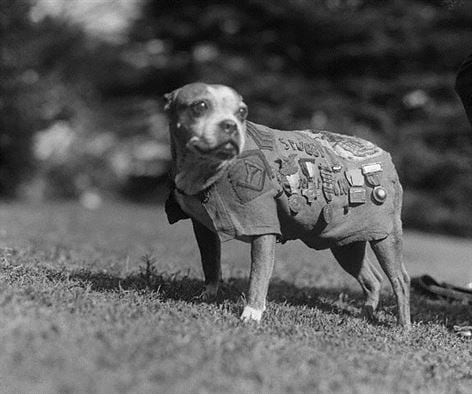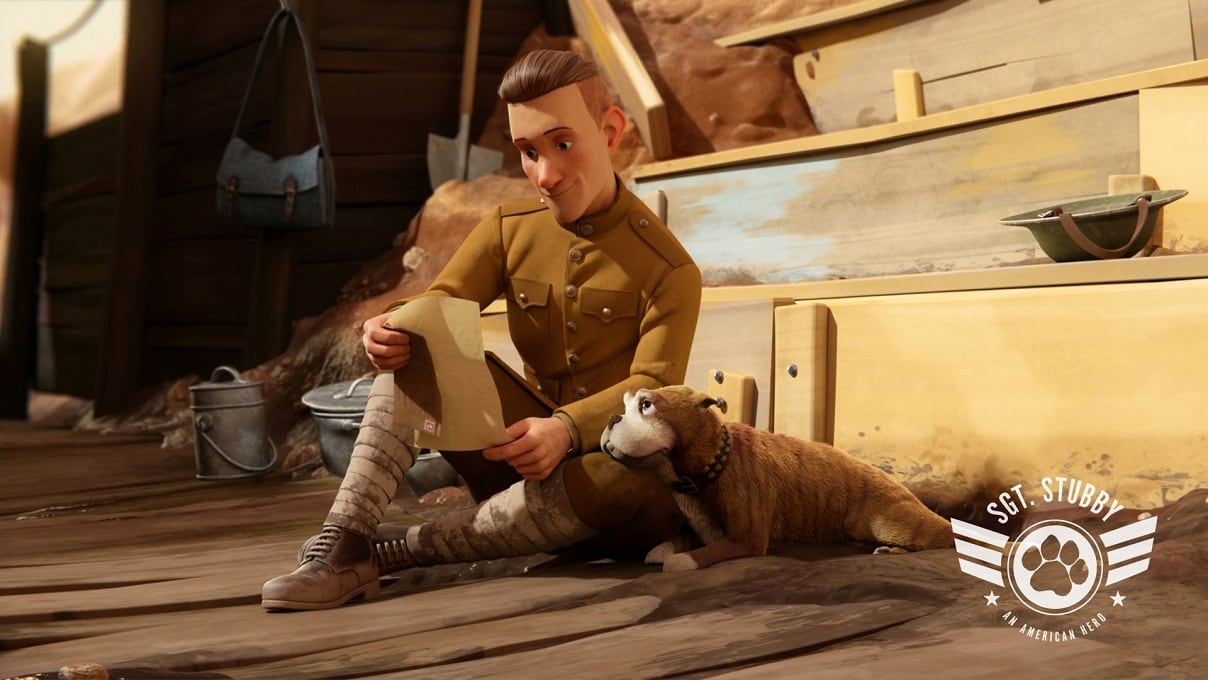If you’ve watched some of the most popular military-related movies and TV shows in recent memory, chances are you’ve seen Marine veteran Mike Stokey’s work.
Stokey, who served three consecutive tours in Vietnam as a combat correspondent, uses his experiences to inject authenticity into Hollywood’s version of the military.
The former sergeant has worked as a military adviser on a variety of movies and shows, including “Born on the Fourth of July,” “Rules of Engagement,” “Band of Brothers,” “Tropic Thunder,” “The Pacific,” “The Thin Red Line” and “Starship Troopers,” just to name a few.
On Friday, he can officially add another one to his list: That day, the animated “Sgt. Stubby: An American Hero,” which Stokey co-wrote, hits theaters nationwide.
The movie tells the true story of a young soldier who adopts a stray dog and names him Stubby after the pup’s short tail. Together, they head to France during World War I, where Stubby reportedly saw front-line action in 17 battles and helped to catch a German spy.
Military Times spoke with Stokey about being a military adviser for Hollywood, and about lending his talents to “Stubby,” which has been endorsed by the World War I Centennial Commission. Answers have been edited for clarity.
RELATED

How did you get involved in this line of work?
[Retired Marine Capt. Dale Dye, who served with Stokey during Vietnam] remained in for 22 years, and after that he was so frustrated with the way movies were made and how the military was looked down upon. He moved to Hollywood, where I was living, and knocked on doors and found out somebody was going to do a little movie about Vietnam. He bowled his way in there saying you need to give me these guys and let me take them to the field for three weeks. That movie turned out to be “Platoon.” I joined up with Dale a couple years later on “Casualties of War,” and from that point on, we’ve been doing a lot of the big ones.
How do you get the word out about what you do?
There’s no agents for what we do. We’ll drop [directors and producers] a line if we hear about a production starting up. We’re kind of known in the business in that small arena. More often than not, they call us. Now of course there’s a lot of competition out there. … In the past, [movies] would hire someone from a branch of service and worry about ribbons on their chest and insignia, that sort of thing. As opposed to really getting the guys dirty and making them dig foxholes and have them walk in boots. It gives actors confidence, and if something goes wrong, an actor will fix the problem right there.

What kind of training and advising do you provide?
It’s directed by the script. We’re not going to teach someone to jump out of a plane if they’re infantry [in the movie]. The script really drives the training schedule for us. We also have to take the era into account. I remember we trained some people, and some of them were military, and they were talking about “Saving Private Ryan” and what they didn’t like, including Tom Hanks pointing his .45[-caliber pistol] at the plane that was coming in. They didn’t like it because he was using one hand, and they were trained to hold it with two hands. But that’s not how it was trained in World War II.
Those things you make adjustments for, too. The way we handled weapons in Vietnam was far different than the way they handle them now.
How did you get involved with the Sgt. Stubby movie?
Dale and I were in France, and Dale met a documentary filmmaker named Richard Lanni. Richard came to Dale asking if he knew anybody that knew animation. I had done a lot of animation writing in the ’90s with Jack [Olesker], the most prolific animation writer in the world. He did all of “He-Man,” and I did a couple of those. So Dale turned Richard over to me, and I co-wrote “Sgt. Stubby.“
Richard gave me an extensive outline. It was in narrative form, not a screenplay, but he wanted to turn it into a screenplay. I created sidekicks and different characters and put military language into it. We expanded his dream about this incredible true story about a dog in World War I.
What drew you to this project?
What intrigued me the most was doing a war story in animation for children. To merge those two genres had never been done. Reflectively, probably with good reason. It’s delicate. Most of the [graphic] stuff needs to be off camera or off screen. You really want to tell a story. A boy, a young private, and his dog — that’s the real meat of this story. I was just intrigued by [Lanni’s] ambitious perspective.
What were some challenges working on the movie?
It was a work in progress. Once we had the script, it was originally for 8-to-10-year-olds. Then we went younger. Even once we started, we had to revise, revise, revise. Little things on the page — some little gems had to be taken out. You hate to do that. Richard took out one of his best lines, but to do that scene would have cost a fortune. It’s very easy to put something on the page.
How do you make sure a military-related movie or TV show feels authentic?
It’s mainly in the language. They don’t talk like civilians, they don’t slouch like civilians. They don’t walk around with their hands in their pockets. You know, little things like that. They salute in different ways than civilians who have never saluted because it’s a thing we learn quite early on. When we were taking people to the field, we’d teach them the weapons and night ambushes and all these things, and we’d get to a scene where the lead actor had to salute. We’d forgotten all about it, thinking it’s easy. And for a civilian who never had to salute, it’s not easy at all. They almost have to practice in front of a mirror. … There’s countless little things like that, aside from the story.

What do you enjoy the most as a military adviser?
The end result. No one really enjoys it while you’re doing it because it’s strenuous. Also the bonding. They’re having a reunion of “Band of Brothers” ... we put these actors through two to three weeks of intensive boot camp and infantry training and lived with them on the set for 10 months. They were submersed in the military to such a degree they even got a hold of all the living characters and keep in touch with them.
What do you hope audiences will take away from the Sgt. Stubby movie?
I hope they find one of the fascinating stories that certainly I never even heard of. A fascinating animal story, a boy and his dog. It’s just an incredible, incredible story. He captured a spy, for crying out loud. My real hope is that every tough decision Richard had to make proves to be right. This is … heartwarming. It’s exciting because of the backdrop of course, a world war. At its heart, it’s about heart. A dog and a young man that discovers him and saves him. And the dog ending up saving him, of course.
Charlsy is a Reporter and Engagement Manager for Military Times. Email her at cpanzino@militarytimes.com.
